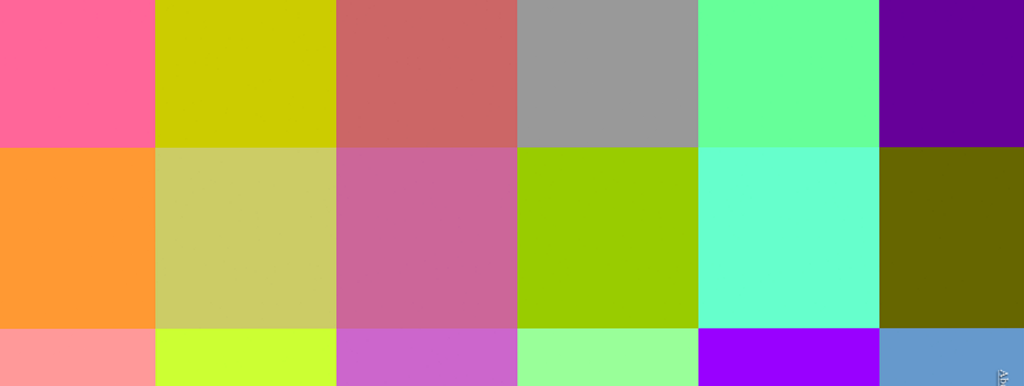Safety in Numbers
Romancing the archive with Web Safe 2k16.

When computers were younger, most of them could display a maximum of 256 colors. But when you went online, different operating systems referred web browsers to different color palettes of their own design. This led to distortion — accidents in color interpretation both pretty and ridiculous. To fix the problem, computers needed to refer to a standardized color palette. These were the 216 web-safe colors. Six shades of red, green, blue, spaced evenly from 00 to FF: 6 x 6 x 6.
Close your eyes and think of a website you loved (or hated!) in 1997 — say, gurl.com or Asian Avenue — and remember the color of the page. Now look at the web-safe colors. It’s in there, you just need to remember hard enough. Don’t tell me you’ve forgotten who you were back then?
The web-safe palette isn’t used any more. It died around the time broadband became widespread. Fearing that we may be forgetting who we were back then, Ben Sisto and Joe Bernardi and I made Web Safe 2k16. Starting February 16 2016, we published one maximum-216 word recollection of a web safe color every day, for 216 days. In our project blurb, we said that we asked our authors “to consider a historical span of roughly 20 years, starting with the widespread availability of VGA monitors and modems in the early ’80s, through O’Reilly Media’s Web 2.0 Conference (2004).” Really, they could write about anything they wanted.
Now, every color has a memory attached to it. It’s not the memory, just a memory. Nothing technical or definitive about it. It’s arbitrary, not organized according to age or gender or race or year or anything like that. Just the hex codes. The finished project is a cabinet of subjectivity, a record of 216 colors experienced by 216 minds.

Some of the above might read as dumb or wrong or way oversimplified to you. But that’s an important element of the project’s philosophy. Embedded in Web Safe 2k16 is the equal claim laid to the internet’s past by every author who wrote for us.
That time in culture belongs to everybody. It belongs to my mum, who barely used the internet until she got an iPad. Somewhere, there has to have been a very old man who could hear the dial-up song down the hall and didn’t know what it was, and died before he could find out. It belongs to the nerd and the non-nerd — it belongs to us all.
That might sound a little romantic, but that’s appropriate for these materials. Color is emotional, and so is memory. My memories of using the internet in the web safe era are memories of early adolescence, so they are high-pitched and intense. Older writers have written much calmer pieces. Younger writers have written about coding as little kids in school. The past is a romantical place, not a scholarly one.
Colors don’t get lonely, perhaps, but our memories do. They sink down into the deepsea of the brain and disintegrate. Web Safe 2k16 asked: do you have an endangered memory, a memory whose material history is all but extinct, and would you like to leave it with us for safekeeping? Most importantly, our invitation asserted somewhat defiantly that the experience of regular people is worth both preserving and romanticising. It is sometimes important to let people tell their own stories, not just to testify.

Below is the last piece of the project, the one I wrote. My color was #00CC66, which was actually the background of an imageboard on which I fell in love. It was totally lawless, gross, and fun. I’m so pleased it doesn’t exist any more.
Working on the internet is a joy, still. It’s not as lawless as it it was back then, but there is still a little space to make things, if you have the time. A person can still make a project of their very own, independent of gods or masters, and it can matter a little. We made Web Safe 2k16 as much for this reason as any other: to prove that there is still a little wilderness left.
So, that’s what I ended up writing about, instead of the boy on the other side of the world.


There is a line in George Eliot’s novel Middlemarch (1871) about a mirror:
“Your pier-glass or extensive surface of polished steel made to be rubbed by a housemaid, will be minutely and multitudinously scratched in all directions; but place now against it a lighted candle as a centre of illumination, and lo! The scratches will seem to arrange themselves in a fine series of concentric circles round the little sun. It is demonstrable that the scratches are going everywhere impartially, and it is only your candle which produces the flattering illusion of a concentric arrangement, its light falling with an exclusive optical selection.”
This parable does not tell us that all things are connected. It tells us that we are each made of the same material. You have led a life with as arbitrary a shape as one of the thousands of scratches upon the screen of the mobile telephone which even now sits inside your pocket or handbag, holding this parable on its surface. Seen in a certain light, all things form a pattern.
This has been a candle
Josephine Livingstone is a writer and academic in New York.
